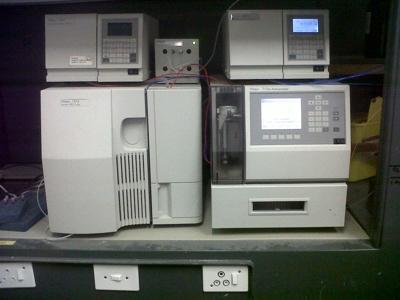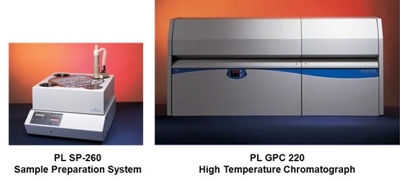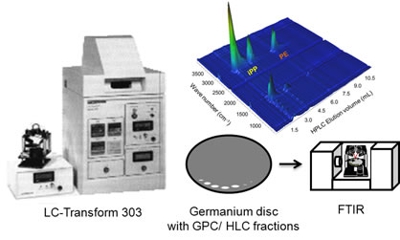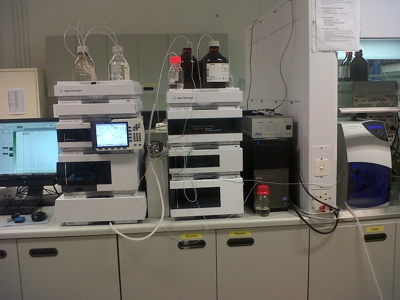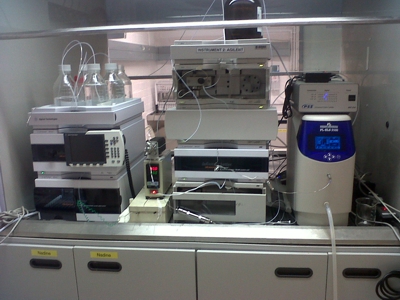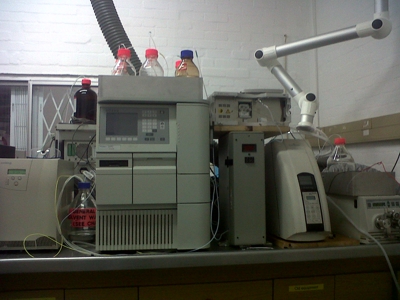Contact us
Division of Polymer Science
Department of Chemistry
and Polymer Science
University of Stellenbosch
Private Bag X1
7602 MATIELAND
South Africa
Telephone:
+27 (21) 808 3172
Where to find us
GPS Coordinates:
S 33° 55' 58" E 18° 51' 59"
Equipment available at Polymer Science
Last revision: 13 November, 2020
Chromatography
GPC / SEC LC Transform 303 SGIC HPLC FFF
Gel permeation chromatography/size exclusion chromatography (GPC/SEC) is the technique of choice for rapid and reliable characterization of macromolecules on the basis of molar mass (Mn), molar mass distribution (MMD) and dispersity (Đ). As the most commonly applied LC technique, the separation is based on the hydrodynamic volume (“effective” molecular size) of molecules in solution and the extent to which they are excluded from the porous particles of the stationary phase. Its attractiveness in molecular characterization of polymers stems from the wide applicability, high speed, ease of use and low sample consumption. Modern SEC employs small rigid, polymeric or silica-based beads of controlled pore size with numerous types of phases commercially available. The subsequent mobile phases can be organic, organic/aqueous or aqueous but more importantly they should be good solvents for the polymer under investigation and be compatible with the stationary phase and the properties of the detector of choice. Furthermore, the choice of column type, its pore size and pore size distribution, the mobile phase and temperature must be carefully selected to achieve high precision and reproducible separation.
Tetrahydrofuran (THF) gel permeation chromatography
Room: 2036
Responsible person: Dr Helen Pfukwa / Joshua Johani, Chelsea Williams
The THF SEC system consists of a Waters 1515 isocratic HPLC pump, a Waters 717plus auto-sampler, Waters 600E system controller (run by Breeze Version 3.30 SPA) and a Waters in-line degasser AF. A Waters 2414 differential refractometer is connected in series with a Waters 2487 dual wavelength absorbance UV/Vis detector operating at variable wavelengths. Tetrahydrofuran (THF, HPLC grade, stabilized with 0.125% BHT) is used as mobile phase, at a flow rate of 1ml/min under the operating temperature of 30oC and an injection volume of 100µl. Two PLgel (Polymer Laboratories) 5µm Mixed-C (300x7.5 mm) columns and a pre-column (PLgel 5µm Guard, 50x7.5 mm) are used. Calibration is done using narrow polystyrene standards ranging from 580 to 2x106 g/mol (Agilent Technologies) and all molecular weights were reported as polystyrene equivalents. Typical applications include analysis of polystyrenes, polycarbonates, elastomers and resins.
Dimethy formamide (DMAc) size exclusion chromatograph
Room: 2036
Responsible person: Dr Helen Pfukwa / CM Smit, L Kellermann, RD Cunningham
The DMAc system consists of a Shimadzu LC-10AD pump, a Waters in-line degasser AF and a Waters 717plus autosampler. A Waters 2487 dual wavelength UV and a Waters 410 differential refractive index (DRI) is connected in series as detection systems. Dimethyl acetamide (DMAc, HPLC grade, stabilized with 0.05% BHT and 0.03% LiCl) is used as mobile phase at 40oC and a flowrate of 1ml/min and the system is calibrated using narrow poly(methylmethacrylate) (PMMA) standards ranging from 634 to 1.944x106 g/mol. The column set include a 50 x 8mm guard column in series with three 300 x 8 mm, 10μm particle size GRAM columns (two 3000Å and a 100Å) obtained from Polymer Standards Service (PSS) and is suitable for the analysis of polar polymers in medium polar solvents e.g. poly(N-vinylpyrrolidone) (PVP), certain polyimides, polyamides, polyacrylates and poly(urethanes).
High temperature chromatograph PL GPC 220
Room: 2035
Responsible person: Dr Helen Pfukwa / Dr Anthony Ndiripo
The PL-GPC 220 is an extremely flexible chromatography system with full automation and equipped with refractive index (RI) detection, used to analyse mostly polyolefins at higher temperatures (150°C). Samples are prepared by using the PL-SP 260 sample preparation system, designed for the dissolution and filtration of samples prior to HT GPC analysis. The unit combines controlled heating across a temperature range of 30 - 260°C, with gentle agitation for the proper dissolution of semi crystalline polyolefins. The mobile phase of Trichlorobenzene is used in combination with an Olexis column set (Agilent Technologies) consisting of one 50 x 7.5mm guard column in series with three 300 x 7.5, 13µm particle size columns. Calibration is done using narrow polystyrene standards ranging from 580 to 2x106 g/mol (Agilent Technologies) and all molecular weights were reported as polystyrene equivalents.
Room: 2035
Responsible person: Dr Helen Pfukwa / Dr Anthony Ndiripo
The LC-Transform is a solvent evaporative interface used to collect the SEC/HPLC separated fractions. The collected fraction on the rotating Germanium disc are further analysed by general FTIR spectroscopy.
This is highly useful for the determination of the chemical structure/physical properties across the molar mass distribution (in combination with HT SEC) or across the chemical composition distribution (in combination with HT HPLC). This application includes the measurement of short chain branching, crystallinity, composition distribution, etc.
Solvent gradient interaction chromatograph
Room: 1013
Responsible person: Dr Helen Pfukwa / Dr Anthony Ndiripo
Solvent gradient interaction chromatograph (SGIC) is a new chromatographic system for high temperature two-dimensional liquid chromatography (HT 2D-LC) analysis, constructed by Polymer Char (Valencia, Spain), comprising of an autosampler, two separate ovens, 2D switching valves and two pumps equipped with vacuum degassers (Agilent, Waldbronn, Germany).
An evaporative light scattering detector (ELSD), PL-ELS 1000, is used as a detector. HT 2D–LC enables the generation of two dimensional characterization data (chemical composition distribution vs molar mass distribution) for all polyolefins over a wider composition range.
High performance liquid chromatography
Agilent 1200
Room: 2034
Agilent 1100
Room: 2034
Responsible person: Dr Helen Pfukwa / Ndumiso Sibanda
The above three HPLC instruments are equipped with a degasser, quaternary pump, auto sampler, thermostatted column oven, isocratic pump, a single ultraviolet detector as well as an evaporative light scattering detector (ELSD). The HPLC instruments are used for the separation of polymers i.e. homopolymers and copolymers and other non-volatile compunds according to their interaction with the column packing. Since polymers are heterogeneous with respect to functionality (end groups), chemical composition (type of repeating units), molecular architecture (i.e. linear or branched) and molar mass (chain length). Careful selection of the type of column and solvent system and column temperature allows for the separation of polymers with regard to the fore mentioned properties.
The quaternary pump allows separation of polymers by using a solvent gradient while the thermostatted column allows for separation of polymers using a temperature gradient. The combination of solvent system and column determine whether you will perform normal phase HPLC or reversed phase HPLC. The above mentioned instruments are able to perform two-dimensional chromatographic experiments which allow separation according to the two preselected properties i.e. in the first dimension you can separate polymers with regard to chemical composition and the second dimension can separate polymers with regard to molar mass by choosing the appropriate columns and solvent systems.
Field flow fractionation can be defined as an elution based chromatography-like method in which the separation is carried out in a single liquid phase. In FFF an external perpendicular field is applied which works in direct concert with the flow pattern in the channel to achieve separation and characterization of polymers, powders, emulsions, environment colloids and many natural materials.
Thermal field flow fractionation (ThFFF)
Room: 2027
Responsible person: Dr Helen Pfukwa / Dr Zanelle Viktor
In ThFFF, the "field" is a temperature gradient imposed across the channel by flat heat-conducting bars positioned on each side of the channel to generate solute migration near one wall (usually the cold one) by thermal diffusion (DT). ThFFF separations are governed by two transport mechanisms acting in opposition DT and D. D (diffusion coefficient) describes the movement of mass against a concentration gradient and it is dependent on the molecular weight. DT is a basic transport coefficient describing the movement of matter under an applied temperature gradient and it is generally independent of the molecular weight, but dependent on chemical composition.
To achieve the temperature gradient, the hot wall is kept at an elevated temperature (Th) through the use of software controlled heating rods and the cold wall is kept cool at lower temperature (Tc) using a recirculating chiller.
In ThFFF separation is based on both molecular weight and chemical composition.
Asymmetrical flow field flow fractionation (AF4)
Room: 2027
Responsible person: Dr Helen Pfukwa / Chelsea Williams
AF4 utilises one permeable bottom wall (accumulation wall) and one solid upper wall. The accumulation wall comprises of a ceramic frit covered by an ultrafiltration membrane, which determines the cut-off molecular weight of samples to be analysed in the channel. Single channel inlet flow is split into the axial (main) flow and the cross flow which is the field.
AF4 is more common due to its high efficiency and simpler construction. Different sized particles are separated by the velocity gradient inside the channel, according to their diffusion coefficient (D), thus separation is dependent on molecular weight and size.
Trapezoidal channel geometry is used in AF4 so as to maintain the axial flow velocity.


